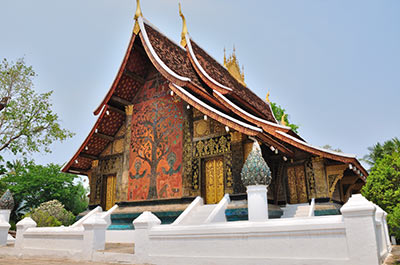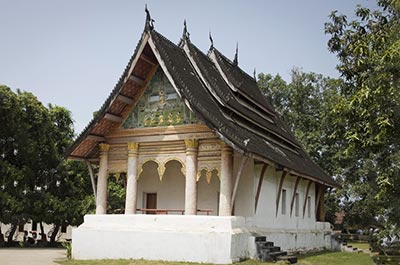
Royal Palace Museum
Last Palace of Laotian Royalty turned into a museum
The former Royal Palace, now turned into a museum is situated on the banks of the Mekong river, facing the sacred Mount Phousi. Locally the Palace is known as the Haw Kham or Ho Kham, which translates to “Golden Palace”.
The museum houses the Phra Bang, the country’s most sacred Buddha image, which is kept in a richly ornamented shrine.
Residence of the Royal Family
The Palace was built between 1904 and 1909 during the time of French colonial occupation as the residence of the Laos Royal Family.
It was built to replace the old Palace after the city had been largely destroyed and looted in 1887 by the Black Flag Army, a militia group from China. While the old Palace was made of traditional building materials like teak wood, the new Palace was made of brick. Its style is a mix of French Beaux Arts and traditional Laos style.
Turned into a museum
When in 1975 the communist Pathet Laos party came to power ending the Laos monarchy, the Royals were forced to leave the Palace, after which it was turned into the National Museum.
Exhibition rooms of the Palace Museum
An avenue lined with palm trees leads to the main entrance on Sisavangvong road. A grand marble staircase with a canon on either side gives access to the Palace Museum. The pediment above the entrance contains a stuccoed depiction of the three headed elephant Airavata ridden by the Hindu God Indra. The golden elephant is sheltered by the White Parasol, a symbol of Royalty and is surrounded by mythological Naga serpents.
At the front of the Palace are the former reception halls, that are now used as the primary exhibition halls. The entrance hall contains a number of Buddha statues, as well as a golden throne used by the Supreme Patriarch of Laos Buddhism during Buddhist ceremonies. Behind the entrance hall is the King’s reception room. It contains statues of the last three Laotian Kings, the murals on its walls depict scenes of daily life in Luang Prabang during the early 20th century. The Queen’s reception room exhibits presents received from foreign state visitors.

Throne Room
At the center of the Palace is the Throne Room, topped with a Laos style spire. The Throne Room with red painted walls decorated with glass mosaics contains a carved throne shaped like a howdah, a seat put on the back of an elephant. The throne was used in previous centuries by the Kings of Laos to travel the Kingdom.
A glass case contains a number of very old gold and crystal Buddha images from the 15th and 16th centuries. Some of them were found in the That Makmo, the stupa of the Wat Wisunalat temple.
The private quarters of the Royal Family are to the back and on either side of the Throne Room. They are kept in the same state as 1975, when the monarchy was overthrown and the Royals left the Palace. The Royal bedrooms, dining room and library still contain the original furniture.
Haw Pha Bang Royal temple
In a corner of the Palace grounds is the Haw Pha Bang, the Royal temple that was built to enshrine the Phra Bang Buddha image.
Other buildings
Other buildings on the grounds include the Royal stables, a shelter where the Royal barges are stored, the former Royal theatre and a garage with the old cars used by the Royals. The Palace gardens contain a large pond as well as a statue of King Sisavang Phoulivong, King of Laos until 1959.
Location
The Palace Museum is located on the Luang Prabang peninsula between the Mekong river and Mount Phousi. The main entrance is on Sisavangvong road.
Getting there
From anywhere on the peninsula, the museum can easily be reached on foot. A tuk tuk or jumbo ride from the center of town will cost between 10,000 (about US$ 1.30) and 15,000 Kip (about US$ 2).
Opening hours
The Royal Palace Museum opens daily except Tuesday from 8 am until 11:30 am and from 1:30 pm until 4 pm.
Taking photographs inside the Museum is not allowed. Cameras and bags can be stored in lockers at the entrance.
Shoes should be removed before entering the building. Please dress respectfully, which means no bare shoulders, short skirts or short pants.
Entrance fee
Admission is 30,000 Kip, about US$ 4 per person.
Luang Prabang
To do & see in Luang Prabang






